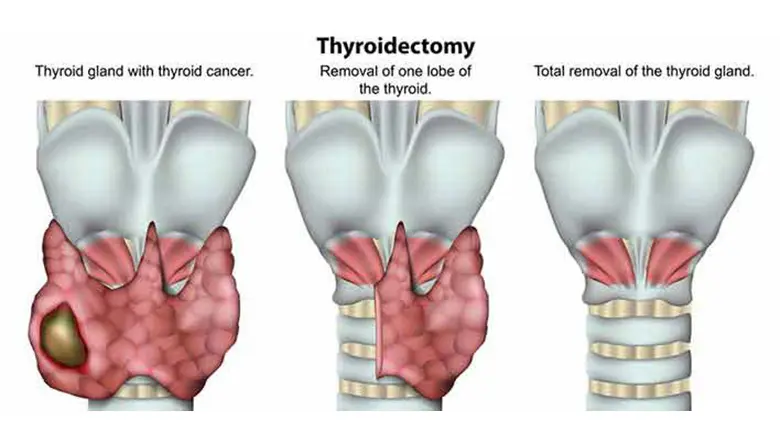What is a thyroidectomy (thyroid gland removal)?

Thyroidectomy is the removal of all or part of your thyroid gland. The thyroid is a small, butterfly-shaped gland in your neck that produces hormones to regulate your metabolism, and is an important function for physiological processes.
How it works
There are several approaches to a thyroidectomy including:
- Conventional, open thyroidectomy, which removes half or the whole thyroid gland through a cut in the lower mid neck.
- Transoral thyroidectomy, which avoids a neck incision by using an incision inside the mouth.
- Endoscopic thyroidectomy, which uses smaller incisions in the neck. Surgical instruments and a small video camera are inserted through the incisions to guide your surgeon through the procedure.
- Robotic thyroidectomy, which is an advanced robotic surgery. Robotic thyroidectomy completely removes the thyroid gland through a point of entry in the armpit instead of the neck, therefore leaving no visible neck scar.
Types of thyroidectomies
Thyroidectomies can be total or partial. The main types of thyroid surgery are:
- Total thyroidectomy – removal of the entire thyroid gland
- Lobectomy or hemithyroidectomy – removal of half of the thyroid gland
- Near-total thyroidectomy – removal of most of the thyroid gland but leaving a little tissue on one side
- Isthmusectomy – removal of the central part of the thyroid gland
Why do you need a thyroidectomy?
Thyroidectomy is used to treat thyroid disorders such as:
- Cancer
- Noncancerous enlargement of the thyroid (goitre)
- Overactive thyroid (hyperthyroidism)
Your doctor may recommend a thyroid removal surgery if you:
- Are suspected of having thyroid cancer.
- Have an enlarged nodule in the thyroid that causes compression of surrounding structures in the neck, such as the trachea (windpipe) or oesophagus.
- Have difficulty swallowing or breathing due to an enlarged thyroid gland or nodule.
- Want a visibly enlarged thyroid near your neck removed for cosmetic reasons.
- Have hyperthyroidism that does not respond to medical treatment.
A thyroidectomy also helps to maintain thyroid hormone levels and create a better sense of well-being.
What are the risks of a thyroidectomy?
A thyroidectomy is generally a safe procedure, but it carries a potential risk of complications including:
- Bleeding, blood clots and airway obstruction as a result of bleeding
- Hypoparathyroidism or low parathyroid hormone levels which can cause numbness, tingling or cramping
- Infection
- Injury to the oesophagus or windpipe
- Nerve damage causing voice changes
- Sore throat
How do you prepare for a thyroidectomy?
Depending on your type of thyroidectomy, your doctor will advise you further on how to prepare, which may include:
- Taking certain medications to control your thyroid function and lower bleeding risk after surgery
- Avoiding eating or drinking for a certain period of time before surgery
- Arranging for transportation home after surgery
What can you expect in a thyroidectomy?
You will typically be given general anaesthesia for your thyroidectomy.
Estimated duration
A thyroidectomy usually takes between 1 – 2 hours or more, depending on the extent of your surgery.
Before the procedure
Your anaesthesiologist will administer anaesthesia medication either as a gas or by injecting the liquid into a vein. A breathing tube will then be placed in your trachea to assist breathing throughout the procedure.
Several monitors will be placed on your body to ensure that your heart rate, blood pressure and blood oxygen levels remain safe during your thyroidectomy.
During the procedure
There are different approaches to a thyroidectomy. Depending on the type of surgery, your surgeon will determine whether to make an incision in the centre of your neck, mouth or armpit.
Incisions are often placed in a skin crease where they will be less visible after healing. All or part of the thyroid gland is then removed.
In most cases, your surgeon will insert a suction drain to prevent fluid from accumulating at the surgery site. This will usually be removed in a day or two after surgery.
After the procedure
After the thyroidectomy, you will be moved to a recovery room for observation. Once fully conscious, you will be transferred to a hospital room.
After a thyroidectomy, some people may experience neck pain and a hoarse or weak voice in the short-term. This may be due to irritation from the breathing tube or due to nerve irritation caused by the surgery.
Care and recovery period for a thyroidectomy
Thyroidectomy recovery depends on your type of surgery. Most patients choose to stay in hospital until the surgical drain has been removed.
You'll be able to eat and drink normally after surgery and can usually return to your regular activities.
Wait at least 10 – 14 days before doing anything vigorous, such as heavy lifting or strenuous sports.
It may take up to 1 year for the thyroidectomy scar to fade. You should avoid exposing the wound to sunlight or use a sunscreen to help reduce discolouration and help the scar fade faster.
If you had a total thyroidectomy, you may require hormone replacement therapy to replace regular thyroid function. Your doctor will advise you on a suitable treatment plan.






